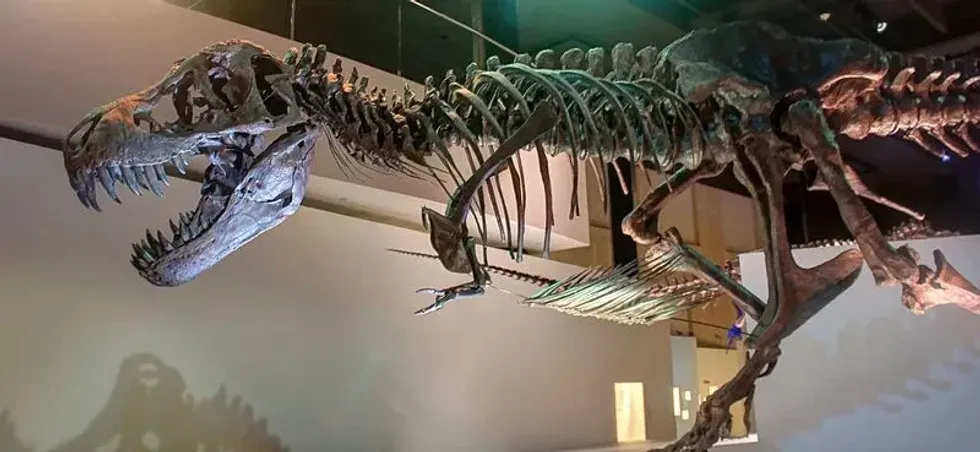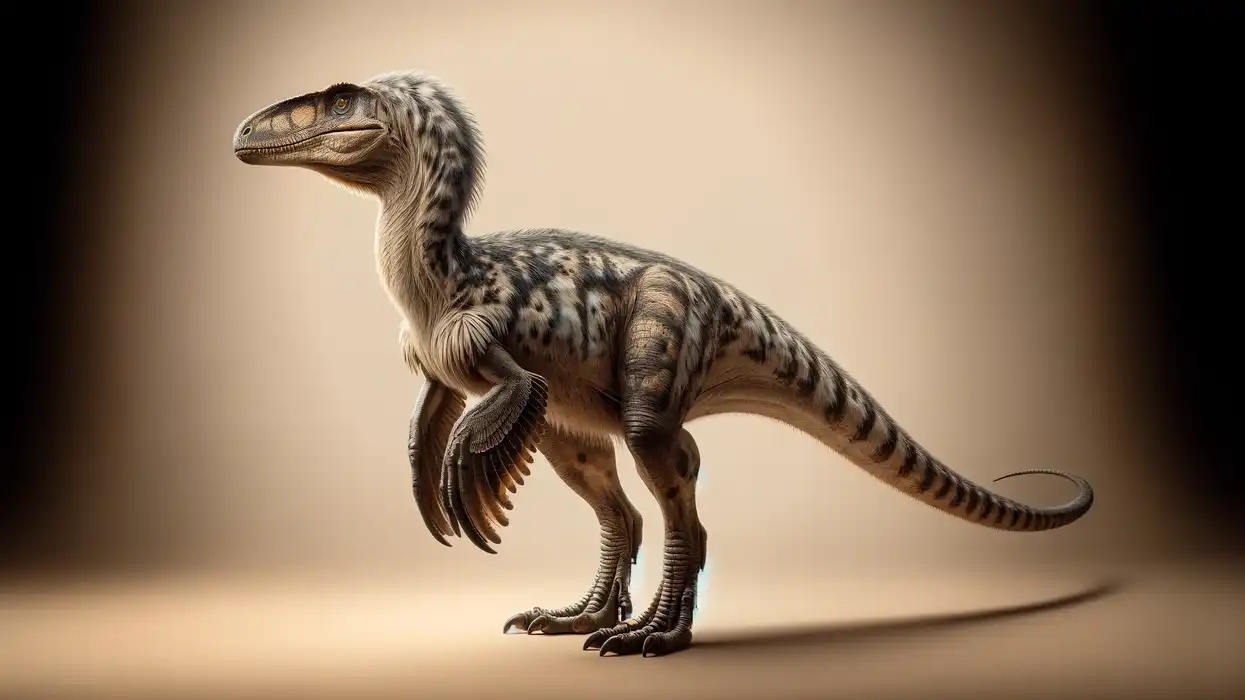Dynamoterror dynastes, a dinosaur that existed 78 million years ago during the Campanian stage of the Late Cretaceous, is one of the most famous tyrannosaurs. The name 'Dynamoterror' has a combination of Greek and Latin words. This naming was done quite recently, in 2018, by Andrew McDonald, one of the discoverers of this dinosaur, along with Douglas Wolfe.
The fossil remains of this dinosaur species have been recovered from New Mexico and consist of frontal bones, other skull elements, and so on. During the Late Cretaceous, this dinosaur occupied the Laramidia region, which was one-half of the North American landmass. The landmass was divided by the Western Interior Seaway.
Many other significant discoveries from the region of Laramidia have also been made. The reconstructed fossil remains of Dynamoterror have provided researchers with a look into the evolution and diversity of tyrannosaurs. Its physical characteristics have led to a better understanding of derived or more advanced theropods.
The size of Dynamoterror was 30 ft (9 m), making it smaller than its relative Tyrannosaurus. However, Dynamoterror was still quite ferocious. The fossil remains of this dinosaur are kept at the National History Museum of Utah.
Dynamoterror Interesting Facts
How do you pronounce 'Dynamoterror'?
The name Dynamoterror is pronounced as 'Dy-nah-mo-teh-ror'. The Dynamoterror dinosaur was discovered by Andrew McDonald and Douglas Wolfe. The naming was done by McDonald, who also described the species. He published the name and description in 2018.
What type of dinosaur was a Dynamoterror?
Dynamoterror dynastes were advanced and derived tyrannosaurid dinosaurs of the Theropoda clade. It was basically a tyrannosaur and was related to similar species of tyrannosaurids, like Tyrannosaurus and Lythronax.
In which geological period did the Dynamoterror roam the earth?
Dynamoterror dynastes existed about 78 million years ago, during the Campanian stage of the Late Cretaceous period. A number of other large-bodied tyrannosaurid dinosaurs also existed during the same time.
When did the Dynamoterror become extinct?
Dynamoterror may have become extinct at the end of the Late Cretaceous. After the Campanian and Maastrichtian ages of the Late Cretaceous, a mass-extinction event took place, killing all dinosaurs. Hence, it is possible this tyrannosaurid dinosaur died then as well.
Where did a Dynamoterror live?
The published information related to Dynamoterror shows that the remains of this species, including parts of the skull and body, were found in New Mexico of the US, North America. This species lived in the Menefee Formation.
During the Late Cretaceous, North America was divided into two halves by the Western Interior Seaway. The area where Dynamoterror lived has been named Laramidia. Laramidia was separated from the other half of North America by the Western Interior Seaway.
What was a Dynamoterror's habitat?
The Menefee Formation, where Dynamoterror lived, was characterized by forests and swamps. In terms of climate, this region was quite humid and hot. The dinosaurs Ornatops and Invictarx were also a part of this formation and ecosystem.
Who did a Dynamoterror live with?
Most tyrannosaurs on record to date have been described as being solitary in nature. Due to the general lack of concrete proof, it can be assumed that Dynamoterror was solitary as well.
How long did a Dynamoterror live?
The exact lifespan of Dynamoterror has not been estimated. However, it probably had a lifespan of 28 years, similar to the Tyrannosaurus rex.
How did they reproduce?
Dynamoterror was an oviparous animal, and hence, its reproductive process involved the formation of eggs, within which the embryonic development would take place. More discoveries are required to establish the exact reproductive science related to this dinosaur.
Dynamoterror Fun Facts
What did a Dynamoterror look like?
 *We've been unable to source an image of Dynamoterror and have used an image of Tyrannosaurus instead. If you are able to provide us with a royalty-free image of Dynamoterror, we could be happy to credit you. Please contact us at hello@kidadl.com.
*We've been unable to source an image of Dynamoterror and have used an image of Tyrannosaurus instead. If you are able to provide us with a royalty-free image of Dynamoterror, we could be happy to credit you. Please contact us at hello@kidadl.com.
Researchers have reconstructed and described some physical features of the Dynamoterror dynastes based on the partial fossil remains that have been discovered. It is quite fascinating to study what these tyrannosaurids looked like.
The skull of Dynamoterror has helped researchers in establishing some key characteristics of this dinosaur. For instance, the frontals or forehead bones had a tall crest.
This crest on the frontals was anatomically essential as it provided a space for the jaw muscles to remain attached. The skull bones indicated the presence of a shallow depression on the upper part of the temporal bone, known as supratemporal fossae.
Apart from these characteristics, Dynamoterror displayed a number of other features, which were common to all tyrannosaurs. For instance, this dinosaur was bipedal in nature.
Its forelimbs were shorter than the hind legs. Additionally, the pre-maxillary teeth in tyrannosaurid dinosaurs had a D-shaped cross-section. The nasals were fused, and the lower jaw and skull bones were provided with air space; hence, these bones displayed pneumaticity.
Overall, the Dynamoterror skeleton was proof that these tyrannosaurids were not as large as the mighty Tyrannosaurus but still were extremely fierce.
How many bones did a Dynamoterror have?
The exact number of bones belonging to Dynamoterror is a mystery that is yet to be unfolded, as a complete skeleton has not been discovered.
Nevertheless, the incomplete remains of an associated skeleton, which went on to be designated as the holotype on record, includes a number of bones like rib fragments, frontals, fragments of vertebral central, parts of the right ilium, right metacarpal II, and so on.
The right frontal belonging to this genus which was discovered had similar dimensions to that of a sub-adult Tyrannosaurus.
Hence, researchers believe that these incomplete remains may have been of a sub-adult or adult Dynamoterror.
Additionally, the features related to the frontals led researchers to establish a new genus for this dinosaur. The fossil remains of Dynamoterror are currently housed at the Natural History Museum of Utah.
How did they communicate?
The exact methods of communication in Dynamoterror are not known. However, when compared to relative members of the Theropoda clade, who communicated through vocalizations and displays, it can be assumed that Dynamoterror dynastes did the same.
How big was a Dynamoterror?
This member of the Tyrannosaurinae sub-family had an estimated length of 30 ft (9 m). The Dynamoterror height is yet to be established. In comparison to another tyrannosaur named Lythronax, which had a length between 24-26 ft (7.3-8 m), the Dynamoterror size was certainly bigger.
How fast could a Dynamoterror move?
Though the speed of Dynamoterror has not been published, due to lack of relevant data, it can be assumed that this tyrannosaurid dinosaur was quite speedy and agile. In general, tyrannosaurs were quite fast. The best example is Tyrannosaurus rex, which had a speed of 16.7 mph (27 kph).
How much did a Dynamoterror weigh?
The estimated weight of Dynamoterror dynastes is 3968 lb (1800 kg). As a member of the group of tyrannosaurid dinosaurs, the weight of Dynamoterror is in a similar range as its related species.
What were the male and female names of the species?
There are no separate names assigned to the male and female Dynamoterror dinosaurs.
What would you call a baby Dynamoterror?
A baby Dynamoterror would be known as a hatchling.
What did they eat?
Dynamoterror dynastes were carnivorous, and hence, they fed on the meat of smaller animals of various kinds. The skull of this member of the Dinosauria clade shows the presence of a crest on the frontals, which was the site of jaw-muscle attachment.
Since this dinosaur had a massive jaw and, consequently, large jaw muscles, it definitely bit through the meat of its prey with a lot of force.
How aggressive were they?
Given the carnivorous nature of this tyrannosaur, it is safe to assume that Dynamoterror was quite aggressive in nature. Apart from its physical features, the name of this dinosaur itself is a clear indication of how aggressive it could've been.
Did you know...
Dynamoterror existed in the same habitat as Brachychampsa, a close relative of the alligators of modern times.
Why is it called Dynamoterror?
The name 'Dynamoterror' was given by Andrew McDonald quite recently, in the year 2018. McDonald and Douglas Wolfe were the ones who made the discovery of this large-bodied tyrannosaur and subsequently described it. The name 'Dynamoterror' is the amalgamation of two words, the Greek word 'Dynamis' and the word of Latin origin, 'Terror'. The word 'Dynamis' stands for power.
McDonald has provided an interesting story behind this nomenclature. When he was young, Tyrannosaurus was known as Dynamosaurus.
However, over time, Dynamosaurus was replaced with the name we know now, Tyrannosaurus. Nevertheless, the name stuck with Andrew McDonald, and hence, when he had the chance to name this dinosaur, he chose the Dynamoterror name. Needless to say, this name does suit the dinosaur well, as it was quite fearsome and definitely spread terror among its prey.
How big was the Dynamoterror compared to other dinosaurs?
Fossil records show Dynamoterror was quite large, with a length of 30 ft (9 m). However, it is intriguing to see how it fared against other tyrannosaurs and also the diversity in size range of the tyrannosaurids discovered to date.
In comparison to the famous Tyrannosaurus rex, which had a length of 40 ft (12 m), Dynamoterror dynastes were certainly smaller.
However, when compared to the Nanuqsaurus, also belonging to the Late Cretaceous, Dynamoterror was larger, as Nanuqsaurus had a length between 16-20 ft (5-6 m).
*We've been unable to source an image of Dynamoterror and have used an image of Tyrannosaurus instead as the main image. If you are able to provide us with a royalty-free image of Dynamoterror, we could be happy to credit you. Please contact us at hello@kidadl.com.









